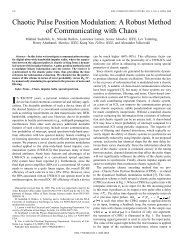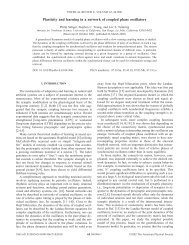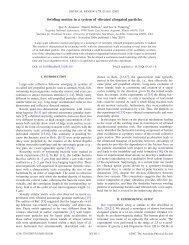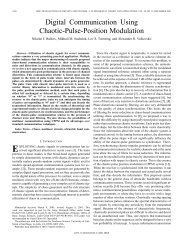A fast, robust and tunable synthetic gene oscillator - The BioCircuits ...
A fast, robust and tunable synthetic gene oscillator - The BioCircuits ...
A fast, robust and tunable synthetic gene oscillator - The BioCircuits ...
Create successful ePaper yourself
Turn your PDF publications into a flip-book with our unique Google optimized e-Paper software.
doi: 10.1038/nature07389 SUPPLEMENTARY INFORMATION<br />
dependent upon the concentrations of arabinose <strong>and</strong> IPTG. Specifically, we defined:<br />
where C max<br />
r<br />
kr = k−r<br />
⎛<br />
<br />
⎜<br />
⎝<br />
C max<br />
r<br />
= 0.2 molecules −1 <strong>and</strong> C min<br />
r<br />
− C min<br />
<br />
r ·<br />
1 +<br />
1<br />
b1 [IPTG]<br />
kr1<br />
+ C min<br />
r<br />
⎞<br />
⎟<br />
⎠ , (1)<br />
= 0.01 molecules −1 are the maximum <strong>and</strong> minimum<br />
affinities of LacI tetramers to the binding site, [IPTG] is the IPTG concentration (in mM), kr1 =<br />
0.035 mM, <strong>and</strong> b1 = 2. Similarly, we defined:<br />
where C max<br />
a<br />
ka = k−a<br />
⎛<br />
<br />
⎜<br />
⎝<br />
C max<br />
a<br />
− C min<br />
<br />
a ·<br />
= 1 molecules −1 <strong>and</strong> C min<br />
a<br />
k c1<br />
a1<br />
[ara] c1<br />
·<br />
+ [ara]c1<br />
1 +<br />
1<br />
b2 [IPTG]<br />
kr2<br />
+ Cmin<br />
a<br />
⎞<br />
⎟<br />
⎠ , (2)<br />
= 0 molecules −1 are the maximum <strong>and</strong> minimum affinities<br />
of AraC dimers to the binding sites, [ara] is the concentration of arabinose (in % w/v), ka1 = 2.5%,<br />
kr2 = 1.8 mM, c1 = 2, <strong>and</strong> b2 = 2.<br />
<strong>The</strong> stochastic simulations were performed using Gillespie’s algorithm (Gillespie 1977) using<br />
custom written software in the C programming language, while deterministic simulations on the<br />
corresponding mass-action ODEs were performed using custom written software in matlab.<br />
<strong>The</strong>oretical predictions of oscillation period versus arabinose concentration<br />
<strong>The</strong>se computational models can also be used to calculate the oscillation period as a function of<br />
arabinose concentration. However, interpretation of the model is complicated by the existence<br />
of two bistable states. <strong>The</strong> first of these states corresponds to the large amplitude (<strong>and</strong> hence<br />
long period) oscillations that are the hallmark of the <strong>oscillator</strong>. In addition to this state, there<br />
is a second state, which for low arabinose levels is a stable limit cycle with very low amplitude<br />
<strong>and</strong> short period. <strong>The</strong> basin of attraction for this limit cycle appears to be very small, so that<br />
it is rarely (if ever) seen stochastically. <strong>The</strong> intrinsic noise of the system ensures that (1) the<br />
probability of reaching this state is small <strong>and</strong> (2) when the system does reside in this state, it<br />
does not remain there for long. This is illustrated in Supplementary Fig. 16A, which shows the<br />
peak-to-peak interval distribution for the stochastic model at 2 mM IPTG <strong>and</strong> 0.233% arabinose.<br />
<strong>The</strong> distribution is unimodal, with a mean that is equal to the period of the large amplitude<br />
oscillations observed in the deterministic model. As the arabinose concentration increases, the<br />
small amplitude limit cycle goes through a Hopf bifurcation near [ara] = 1.83%, above which<br />
the limit cycle becomes a stable fixed point. Stochastically, however, the intrinsic noise creates<br />
small-amplitude noise-induced oscillations whenever the system is near the fixed point. <strong>The</strong><br />
system will most often reside in the large amplitude oscillation state, but will occasionally jump<br />
to the noise-induced oscillations for brief periods of time. For example, Supplementary Fig. 17<br />
shows a typical trajectory obtained from stochastic simulations. <strong>The</strong> basin of attraction of these<br />
noise-induced oscillations becomes larger as the arabinose concentration is increased. This can<br />
be seen in Supplementary Fig. 16B–C, which show the peak-to-peak interval distributions for<br />
[ara] = 2.1% <strong>and</strong> [ara] = 3.5%, respectively. Just above the Hopf point (Supplementary Fig. 16B),<br />
www.nature.com/nature<br />
23







